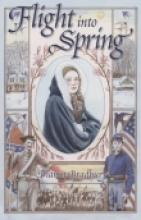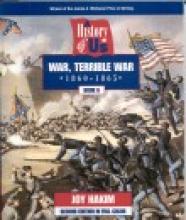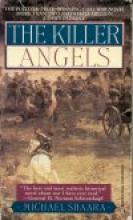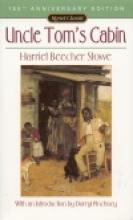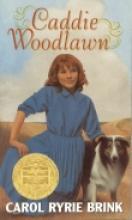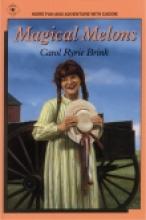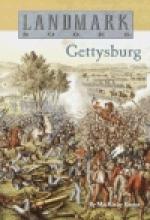Civil War
Flight into Spring
Subject(s):
Setting:
Grade / Age level:
Review:
This is a sweet, but challenging story about a 16 year old girl from pro-Confederate Maryland who marries a Union soldier from Connecticut just after the Civil War. The story presents the conflicts of hard feelings and the need for healing between North and South in the context of family relationships. It seems quite unusual as stories usually lead up to an unknown "happily ever after." Here, the emphasis is on this young bride's married life. Cultural and religious differences as well as bitterness from the war make life quite difficult for this young bride living with her husband on his parents' farm. The story makes an interesting backdrop to consider ideas about developing relationships, the give-and-take necessary in marriage and the idea of love and commitment. Appropriate for ages 12 and up.
Reviewed by:
First reviewed:
6-24-05
History of Us, Volume 6: War, Terrible War
Subject(s):
Setting:
Grade / Age level:
Review:
This is an interesting, very readable overview of the Civil War. There is a significant focus on the issue of slavery as a plague upon American culture of the time. The author's basic thesis is that, while different people fought for different reasons and the focus was especially blurred when the war began (when there was more emphasis on preservation of the union), the war was essentially fought over the issue of slavery.
Although the author herself is not consistent on this issue in her final volume, a lot can be learned from studying her stories, ideas and conclusions about slavery in light of the current abortion debate. A thoughtful older student might even study this volume thoroughly and compare it with Hakim's significantly-problematic treatment of the 20th century. Hakim makes a significant effort to be fair to the intentions of both North and South while clearly believing that the North has the upper moral hand on the slavery issue.
Although the writing style is quite engaging, all the side bar quotes and information do make a cover-to-cover reading a little choppy. This volume could be used very beneficially as a "spine book" to tie together a study of the Civil War with an emphasis on great stories such as Uncle Tom's Cabin and Killer Angels. Most approriate for grades 6-8 but usable for anyone studying the Civil War. The book can have the effect of kindling an interest in the topic and inviting the student to learn more on their own.
Although the author herself is not consistent on this issue in her final volume, a lot can be learned from studying her stories, ideas and conclusions about slavery in light of the current abortion debate. A thoughtful older student might even study this volume thoroughly and compare it with Hakim's significantly-problematic treatment of the 20th century. Hakim makes a significant effort to be fair to the intentions of both North and South while clearly believing that the North has the upper moral hand on the slavery issue.
Although the writing style is quite engaging, all the side bar quotes and information do make a cover-to-cover reading a little choppy. This volume could be used very beneficially as a "spine book" to tie together a study of the Civil War with an emphasis on great stories such as Uncle Tom's Cabin and Killer Angels. Most approriate for grades 6-8 but usable for anyone studying the Civil War. The book can have the effect of kindling an interest in the topic and inviting the student to learn more on their own.
Perspective:
secular
Reviewed by:
First reviewed:
9-19-02
The Killer Angels
Subject(s):
Setting:
Grade / Age level:
Review:
This is really a rather remarkable novel about the battle of Gettysburg, Pennsylvania - probably the most famous battle of the Civil War. The Southern Armies, under General Lee, decided to invade the North in order to strike a blow that would "hit home" and make the Northerners wish to end the war. North and South met in the small farming town of Gettysburg in Pennsylvania and engaged in bloody battle for three days. The cost in human life was devastating to both sides. The defeat of the South at this battle seemed avoidable, but turned out to be decisive in the overall outcome of the war.
What is remarkable about this book is both the completeness of the picture we are given of the importance and complexity of the battle and the humanity of its key players. It is surprisingly unbiased toward either side, instead focusing on understanding the multitude of motivations that influenced the key players. The book contains twenty-three chapters. Each chapter tells a piece of the story from the point of view of different characters (a number of the characters have more than one chapter - four chapters are from General Lee's point of view, six chapters are from Colonel Chaberlain's point of view, etc.) The author seems to take special care in elaborating upon the South's General Longstreet and the North's Colonel Chamberlain.
High school students and adults will come away from this book with a much fuller sense of the gravity and scope of the civil war. It is intense, although not overly graphic and does contain some coarse language (which is both realistic and not overdone).
Note: The recent movie, Gettysburg, is based on this book and is quite good. It is remarkably non-gory without destroying the necessary sense of reality. I would recommend reading the book first as it provides some details not shown in the movie and makes it much easier to follow the multitude of characters. My one caveat is that I didn't care for the way General Lee was portrayed in the movie. They left out some important details that would have affected his admittedly poor decisions (namely his bad health) and in general, I found Martin Sheen's portrayal too buffoonish and undignified in contrast with the book.
What is remarkable about this book is both the completeness of the picture we are given of the importance and complexity of the battle and the humanity of its key players. It is surprisingly unbiased toward either side, instead focusing on understanding the multitude of motivations that influenced the key players. The book contains twenty-three chapters. Each chapter tells a piece of the story from the point of view of different characters (a number of the characters have more than one chapter - four chapters are from General Lee's point of view, six chapters are from Colonel Chaberlain's point of view, etc.) The author seems to take special care in elaborating upon the South's General Longstreet and the North's Colonel Chamberlain.
High school students and adults will come away from this book with a much fuller sense of the gravity and scope of the civil war. It is intense, although not overly graphic and does contain some coarse language (which is both realistic and not overdone).
Note: The recent movie, Gettysburg, is based on this book and is quite good. It is remarkably non-gory without destroying the necessary sense of reality. I would recommend reading the book first as it provides some details not shown in the movie and makes it much easier to follow the multitude of characters. My one caveat is that I didn't care for the way General Lee was portrayed in the movie. They left out some important details that would have affected his admittedly poor decisions (namely his bad health) and in general, I found Martin Sheen's portrayal too buffoonish and undignified in contrast with the book.
Reviewed by:
First reviewed:
10-17-01
The Story of the Pony Express
Number of pages:
32 pages
Copyright:
1981
Publisher:
Cornerstones of Freedom Series
Binding:
Other
Subject(s):
Setting:
Grade / Age level:
Review:
Although I expect that this series was designed for mid-grade school, my younger children have still found it to be very interesting for read-alouds. The story of the Pony Express tends to be one of rather high interest for young children, but one that is given very brief mention in most history textbooks. I found it very interesting to discover that the Pony Express only ran for a year and a half, how it was affected by the California Gold Rush and the Civil War and how it paved the way for running of telegraph lines coast to coast which made the service obsolete. Several rather colorful figures, including Buffalo Bill and Wild Bill Hickok worked for the Pony Express and Mark Twain wrote about his brief encounter with a Pony Express rider while journeying on a stagecoach.
Additional notes:
Various editions available
Reviewed by:
First reviewed:
12-27-99
Uncle Tom's Cabin
Subject(s):
Setting:
Grade / Age level:
Review:
There are a plethora of resources for you to find out the plot of this book out on the web and in the bookstores (eg. Cliffs Notes!!). Many contain "spoilers". And this is OK - after all it's a classic. Moreover, the book is good even if you know what is going to happen. I had the enjoyable luxury of reading this book without having run across the spoilers and with no real knowledge of the plot. I was not required to read it in school - oh happy fault.
The story is about slavery in America. It follows the lives of two slaves in detail, Eliza and Uncle Tom, and introduces us to a great many more slaves and masters and their stories. The two belong to the same master in Kentucky. When the master falls on hard times (from his own inability to manage his estate) he ends up making a deal to sell these two - despite the fact that both of them are rather dear to him and his family. Getting wind of this Eliza decides to run for safety with her son while Uncle Tom allows himself to be taken away from his wife and young children. Eliza risks her life to save her child - running across the ice floes of a partially frozen Ohio river to escape - then finds her way along an underground network. (I won't tell you how her story comes out.) Uncle Tom is sold and resold. He is steadfast in his faith throughout - though not unchanging. Moreover, he affects those who he meets along the way.
This book is written in a very foreign style. - at least to the modern reader. Chronologically Mrs. Stowe's style fits somewhere between that of the crafters of the Constitution and that of Mark Twain. But it is not so easy to put it into any other category. Her own narration is a bit archaic, overtly Christian, sometimes sarcastic, sometimes patronizing, and yet very broad minded. She calls you "gentle reader". She says "now don't you think that is fair?" when she expects you to come to the opposite conclusion. And yet she sees clearly through all the haze of the issue - i.e. the "shades of grey" everyone loves to talk about when they can't bear to say right vs. wrong. And she does more - she presents us with characters who take various positions on the slavery issue. Not just "it's right" and "it's wrong" - but a wide variety of views. She allows them ample voice and reason to discourse their whole argument; she does not make them straw men; she does not mitigate or twist their ideas; she lays out the best cases for and against - and from several different angles. In the midst of this she demonstrates the effects on the PEOPLE who are subjected to the system - those who are the masters as well as those who are the slaves. It is incredibly revealing to have the whole gamut - the entire conversation - all in one accessable story. And it is incredibly convincing!!! Which is why, as legend has it, Abe Lincoln, when introduced to her for the first time declared, "So you're the little lady responsible for this big war."
This book ought to be read for a lot of different reasons.
1) Arguments aren't just fights. When properly done they are tools to get at the truth. This book shows how to argue in the best sense. Reasonable people may have views that are wrong - and can be changed by convincing. (Admittedly, most of those in this book are not, ultimately, convinced - but some are - it's good to see).
2) Style! You have to get a taste of this style of hers. It is a peculiar dish that we rarely see set before us these days (how much early 19th century do you typically read!!).
3) Faith. Uncle Tom has faith in God. It grows stronger and better through his trials. And, it has effects on those he meets and deals with to different degrees and in different ways. (That's realistic.)
4) It shows us that a story can be an extremely convincing form of persuasion.
5) There is a lot revealed about the fundamental nature of man and his free will by exploring the effects of stifling that free will via enslavement. Her characters vary wildly in their reaction to the invisible wall between master and slave. The slaves will react, contort and re-form (or de-form) themselves to this unnatural order. The slave owners must likewise be ignorant or somehow justify their actions. To the author's credit we see that the justification is sometimes wicked or perverted and sometimes just well-meaning but ultimately flawed reasoning.
6) One thing that kind of percolates up from 5) is that there is a difference between the will and the intellect. Philosophers have argued about this for millenia. Many people believe that if someone knows what the good thing is they will naturally want to do it. But knowing and doing ARE different. And some may know what is good but not do it. Some may even want to do what is not good and through an underhanded twist of the will convince themselves (and really THINK they know) that the bad is good. The sooner a person can grasp the difference between the intellect and the will the more they will be able to direct their own thoughts and actions maturely, profitably and honorably.
7) Believe it or Not! This book has some incredible (as in not believable) events. However, Mrs. Stowe, it turns out had done a lot or research. Most of the events were gathered from real events. Even the more incredible ones such as Eliza crossing the river. - Don't try that at home!!!
Age level: High School Freshman +/- a year. Kleenex required.
The story is about slavery in America. It follows the lives of two slaves in detail, Eliza and Uncle Tom, and introduces us to a great many more slaves and masters and their stories. The two belong to the same master in Kentucky. When the master falls on hard times (from his own inability to manage his estate) he ends up making a deal to sell these two - despite the fact that both of them are rather dear to him and his family. Getting wind of this Eliza decides to run for safety with her son while Uncle Tom allows himself to be taken away from his wife and young children. Eliza risks her life to save her child - running across the ice floes of a partially frozen Ohio river to escape - then finds her way along an underground network. (I won't tell you how her story comes out.) Uncle Tom is sold and resold. He is steadfast in his faith throughout - though not unchanging. Moreover, he affects those who he meets along the way.
This book is written in a very foreign style. - at least to the modern reader. Chronologically Mrs. Stowe's style fits somewhere between that of the crafters of the Constitution and that of Mark Twain. But it is not so easy to put it into any other category. Her own narration is a bit archaic, overtly Christian, sometimes sarcastic, sometimes patronizing, and yet very broad minded. She calls you "gentle reader". She says "now don't you think that is fair?" when she expects you to come to the opposite conclusion. And yet she sees clearly through all the haze of the issue - i.e. the "shades of grey" everyone loves to talk about when they can't bear to say right vs. wrong. And she does more - she presents us with characters who take various positions on the slavery issue. Not just "it's right" and "it's wrong" - but a wide variety of views. She allows them ample voice and reason to discourse their whole argument; she does not make them straw men; she does not mitigate or twist their ideas; she lays out the best cases for and against - and from several different angles. In the midst of this she demonstrates the effects on the PEOPLE who are subjected to the system - those who are the masters as well as those who are the slaves. It is incredibly revealing to have the whole gamut - the entire conversation - all in one accessable story. And it is incredibly convincing!!! Which is why, as legend has it, Abe Lincoln, when introduced to her for the first time declared, "So you're the little lady responsible for this big war."
This book ought to be read for a lot of different reasons.
1) Arguments aren't just fights. When properly done they are tools to get at the truth. This book shows how to argue in the best sense. Reasonable people may have views that are wrong - and can be changed by convincing. (Admittedly, most of those in this book are not, ultimately, convinced - but some are - it's good to see).
2) Style! You have to get a taste of this style of hers. It is a peculiar dish that we rarely see set before us these days (how much early 19th century do you typically read!!).
3) Faith. Uncle Tom has faith in God. It grows stronger and better through his trials. And, it has effects on those he meets and deals with to different degrees and in different ways. (That's realistic.)
4) It shows us that a story can be an extremely convincing form of persuasion.
5) There is a lot revealed about the fundamental nature of man and his free will by exploring the effects of stifling that free will via enslavement. Her characters vary wildly in their reaction to the invisible wall between master and slave. The slaves will react, contort and re-form (or de-form) themselves to this unnatural order. The slave owners must likewise be ignorant or somehow justify their actions. To the author's credit we see that the justification is sometimes wicked or perverted and sometimes just well-meaning but ultimately flawed reasoning.
6) One thing that kind of percolates up from 5) is that there is a difference between the will and the intellect. Philosophers have argued about this for millenia. Many people believe that if someone knows what the good thing is they will naturally want to do it. But knowing and doing ARE different. And some may know what is good but not do it. Some may even want to do what is not good and through an underhanded twist of the will convince themselves (and really THINK they know) that the bad is good. The sooner a person can grasp the difference between the intellect and the will the more they will be able to direct their own thoughts and actions maturely, profitably and honorably.
7) Believe it or Not! This book has some incredible (as in not believable) events. However, Mrs. Stowe, it turns out had done a lot or research. Most of the events were gathered from real events. Even the more incredible ones such as Eliza crossing the river. - Don't try that at home!!!
Age level: High School Freshman +/- a year. Kleenex required.
Additional notes:
Many editions available
Reviewed by:
First reviewed:
7-29-04
Caddie Woodlawn
Subject(s):
Setting:
Grade / Age level:
Review:
Caddie Woodlawn is the story of a young tom-boyish girl who grew up in pioneer Wisconsin during the Civil War (this story predates the first book of the Little House series by about 25 years - but they are quite close geographically). Caddie's father was the grandson of an English Lord, but as his mother was from the lower classes, his father was disowned and the family grew up impoverished. He emigrated to America where he married a charming Boston lady with whom he raised a family of eight children. They moved to Wisconsin when Caddie (short for Caroline) was very young. Soon after their move (still before the story begins) they lost their five year old girl due to her sickly "constitution". Because of this, Caddie's parents decide to let her grow up in the out-of-doors where she spends a great deal of time adventuring in their nearby woods with her brothers. (This was quite uncommon for girls in those days.) There they meet real-life Indians and develop a curious friendship with them. They also hear somewhat wild Irish folktales from their golden-hearted Irish farmhand (you may want to read these tales yourself before presenting them to little ones), and are involved in a real-life "Incredible Journey" when their dog, Nero, amazingly returns to them after being lost several states away. Caddie's mother still does have an influence on her daughter and over the course of the story (in which Caddie is 11 years old) Caddie begins to develop a sense of what it means to be a lady, despite her rough ways. Like the Little House books, this story is neither Catholic nor particularly religious, but full of good old-fashioned family values and a proper devotion to parents - you particularly see the children's strong admiration for their father, who is simple, honest, hardworking, understanding, and plays a very active role in his children's daily lives.
The story is written by Caddie's granddaughter who, orphaned at a young age, was actually raised by Caddie and grew up listening to these stories from her grandmother's childhood. This grandmotherly wisdom shows through in the book in the way the stories were selected and told.
Our family recently enjoyed visiting Caddie Woodlawn Historic Park, near the Minnesota border in Western Wisconsin. It's a very simple place where you can walk through Caddie's house (no tourist guides or anything - you just walk through the empty house on your own) and visit a memorial to Caddie's sister Mary who is buried in an unknown place on the property. Reading this book (and visiting Caddie's house) were good opportunities for me as a mother to reflect on some of John Senior's ideas from the Restoration of Christian Culture on the benefits of a simpler life.
On a related note: I found the movie (of the same name) done by Wonderworks terribly disappointing. Most notably, they took one of my (and apparently the author's) favorite characters - the noble and loving Robert Ireton, and turned him into a mean and cowardly character.
The story is written by Caddie's granddaughter who, orphaned at a young age, was actually raised by Caddie and grew up listening to these stories from her grandmother's childhood. This grandmotherly wisdom shows through in the book in the way the stories were selected and told.
Our family recently enjoyed visiting Caddie Woodlawn Historic Park, near the Minnesota border in Western Wisconsin. It's a very simple place where you can walk through Caddie's house (no tourist guides or anything - you just walk through the empty house on your own) and visit a memorial to Caddie's sister Mary who is buried in an unknown place on the property. Reading this book (and visiting Caddie's house) were good opportunities for me as a mother to reflect on some of John Senior's ideas from the Restoration of Christian Culture on the benefits of a simpler life.
On a related note: I found the movie (of the same name) done by Wonderworks terribly disappointing. Most notably, they took one of my (and apparently the author's) favorite characters - the noble and loving Robert Ireton, and turned him into a mean and cowardly character.
Reviewed by:
First reviewed:
1998-99
Magical Melons
Subject(s):
Setting:
Grade / Age level:
Review:
This is a delightful collection of additional stories about Caddie Woodlawn and her family (and one additional story as explained in the introduction that doesn't quite belong). These stories take place between 1863 and 1866 and so in some places overlap the original stories in Caddie Woodlawn which took place in 1864. Here each chapter stands alone as an interesting and true story and many are very touching and beautiful. The first, from which comes the title Magical Melons, is the story of how the three oldest children discovered a large number of perfect watermelons in the hayloft in the barn. Childishly believing them to have magically appeared there, they quietly devoured a large number of them over the course of several weeks. It turns out that the farm hand Robert Ireton had hidden them there to provide a surprise for the family later in the fall when they would be unexpected. When he went to pull them out there were only a few left and Tom, Caddie and Warren had to sit by while the rest of the family enjoyed what was left of the treat.
This book would make a delightful read aloud for the whole family and should be required reading, along with Caddie Woodlawn, for those studying Wisconsin history
This book would make a delightful read aloud for the whole family and should be required reading, along with Caddie Woodlawn, for those studying Wisconsin history
Reviewed by:
First reviewed:
9-14-2000
Gettysburg
Subject(s):
Setting:
Grade / Age level:
Review:
The Civil War Battle of Gettysburg, Pennsylvania (July 1 - 3, 1863) is a complex, multi-faceted piece of history that would be difficult to understand after reading just one book. If you ever find yourself in the South-Central Pennsylvania, I would recommend a visit. I've been there twice and it's very a moving, historically interesting site.
This book offers a glimpse into a number of aspects of the human side of the war. The author met with a number of Civil War veterans personally, and so the accounts contained within the book are very human and anecdotal. He tries to give us a sense of the flavor of life in that time period; the way people thought about each other - particularly those on opposite sides of the Potomac River.
Like many Landmark books, this probably isn't the first place you want to turn to in studying about Gettysburg - and this one isn't quite as cohesive as I would like. I think it would be most interesting and accessible to upper grade schoolers who had already become familiar with events in a general way from a textbook or from a visit to the battlefield. My 11 year old daughter tackled this independently this past year in the midst of other books on the civil war, bits and pieces of Ken Burns' Civil War Documentary and enjoyed and benefited from it.
This book offers a glimpse into a number of aspects of the human side of the war. The author met with a number of Civil War veterans personally, and so the accounts contained within the book are very human and anecdotal. He tries to give us a sense of the flavor of life in that time period; the way people thought about each other - particularly those on opposite sides of the Potomac River.
Like many Landmark books, this probably isn't the first place you want to turn to in studying about Gettysburg - and this one isn't quite as cohesive as I would like. I think it would be most interesting and accessible to upper grade schoolers who had already become familiar with events in a general way from a textbook or from a visit to the battlefield. My 11 year old daughter tackled this independently this past year in the midst of other books on the civil war, bits and pieces of Ken Burns' Civil War Documentary and enjoyed and benefited from it.
Reviewed by:
First reviewed:
12-29-04

